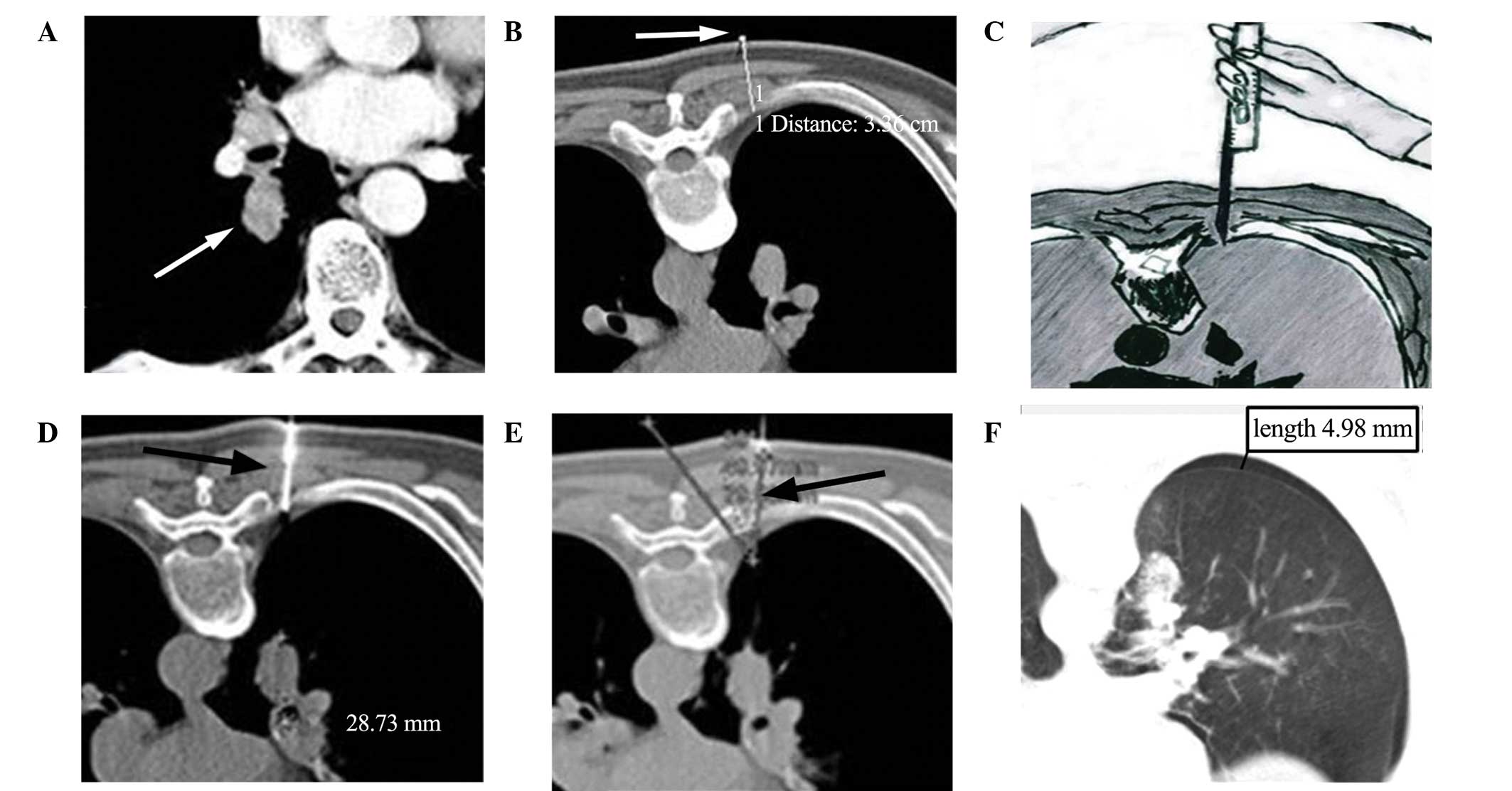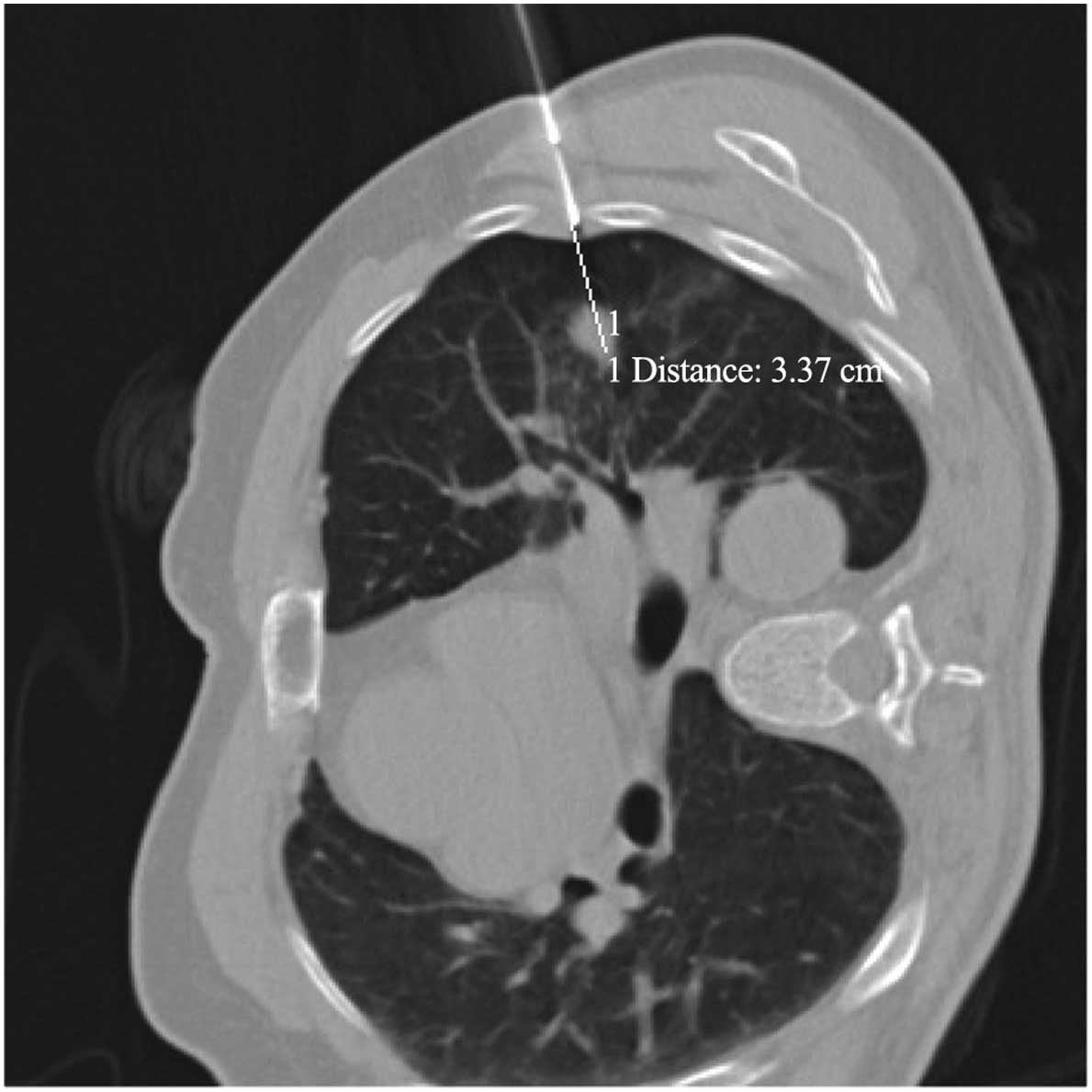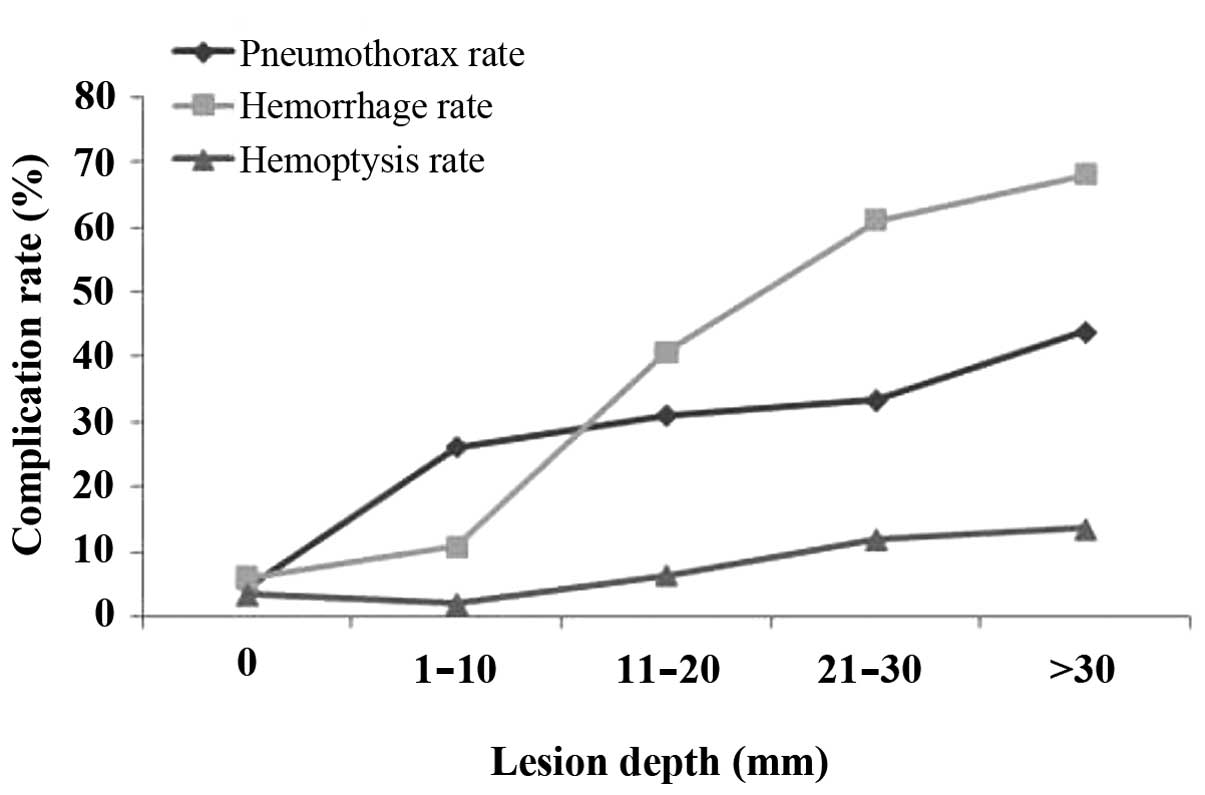|
1
|
Wallace MJ, Krishnamurthy S, Broemeling
LD, Gupta S, Ahrar K, Morello FA Jr and Hicks ME: CT-guided
percutaneous fine-needle aspiration biopsy of small (≤1 cm)
pulmonary lesions. Radiology. 225:823–828. 2002. View Article : Google Scholar : PubMed/NCBI
|
|
2
|
Laurent F, Latrabe V, Vergier B, Montaudon
M, Vernejoux JM and Dubrez J: CT-guided transthoracic needle biopsy
of pulmonary nodules smaller than 20 mm: Results with an automated
20-gauge coaxial cutting needle. Clin Radiol. 55:281–287. 2000.
View Article : Google Scholar : PubMed/NCBI
|
|
3
|
Guimaraes MD, de Andrade MQ, da Fonte AC,
Chojniak R and Gross JL: CT-guided cutting needle biopsy of lung
lesions - an effective procedure for adequate material and specific
diagnose. Eur J Radiol. 80:e488–e490. 2011. View Article : Google Scholar : PubMed/NCBI
|
|
4
|
Wu RH, Tzeng WS, Lee WJ, Chang SC, Chen
CH, Fung JL, Wang YJ and Mak CW: CT-guided transthoracic cutting
needle biopsy of intrathoracic lesions, comparison between coaxial
and single needle technique. Eur J Radiol. 81:e712–e716. 2012.
View Article : Google Scholar : PubMed/NCBI
|
|
5
|
Hiraki T, Mimura H, Gobara H, Iguchi T,
Fujiwara H, Sakurai J, Matsui Y, Inoue D, Toyooka S, Sano Y and
Kanazawa S: CT fluoroscopy-guided biopsy of 1,000 pulmonary lesions
performed with 20-gauge coaxial cutting needles: Diagnostic yield
and risk factors for diagnostic failure. Chest. 136:1612–1617.
2009. View Article : Google Scholar : PubMed/NCBI
|
|
6
|
Geraghty PR, Kee ST, McFarlane G, Razavi
MK, Sze DY and Dake MD: CT-guided transthoracic needle aspiration
biopsy of pulmonary nodules: Needle size and pneumothorax rate.
Radiology. 229:475–481. 2003. View Article : Google Scholar : PubMed/NCBI
|
|
7
|
Gupta S, Krishnamurthy S, Broemeling LD,
Morello FA Jr, Wallace MJ, Ahrar K, Madoff DC, Murthy R and Hicks
ME: Small (</=2-cm) subpleural pulmonary lesions: Short-versus
long-needle-path CT-guided Biopsy - comparison of diagnostic yields
and complications. Radiology. 234:631–637. 2005. View Article : Google Scholar : PubMed/NCBI
|
|
8
|
Haramati LB and Aviram G: What constitutes
effective management of pneumothorax after CT-guided needle biopsy
of the lung? Chest. 121:1013–1015. 2002. View Article : Google Scholar : PubMed/NCBI
|
|
9
|
Klein JS, Salomon G and Stewart EA:
Transthoracic needle biopsy with a coaxially placed 20-gauge
automated cutting needle: Results in 122 patients. Radiology.
198:715–720. 1996. View Article : Google Scholar : PubMed/NCBI
|
|
10
|
Saji H, Nakamura H, Tsuchida T, Tsoboi M,
Kawate N, Konaka C and Kato H: The incidence and the risk of
pneumothorax and chest tube placement after percutaneous CT-guided
lung biopsy: The angle of the needle trajectory is a novel
predictor. Chest. 121:1521–1526. 2002. View Article : Google Scholar : PubMed/NCBI
|
|
11
|
Beşir FH, Altin R, Kart L, Akkoyunlu M,
Ozdemir H, Ornek T and Gündoğdu S: The results of computed
tomography guided tru-cut transthoracic biopsy: Complications and
related risk factors. Wien Klin Wochenschr. 123:79–82. 2011.
View Article : Google Scholar : PubMed/NCBI
|
|
12
|
Khan MF, Straub R, Moghaddam SR, Maataoui
A, Gurung J, Wagner TO, Ackermann H, Thalhammer A, Vogl TJ and
Jacobi V: Variables affecting the risk of pneumothorax and
intrapulmonal hemorrhage in CT-guided transthoracic biopsy. Eur
Radiol. 18:1356–1363. 2008. View Article : Google Scholar : PubMed/NCBI
|
|
13
|
Yeow KM, Su IH, Pan KT, Tsay PK, Lui KW,
Cheung YC and Chou AS: Risk factors of pneumothorax and bleeding:
Multivariate analysis of 660 CT-guided coaxial cutting needle lung
biopsies. Chest. 126:748–754. 2004. View Article : Google Scholar : PubMed/NCBI
|
|
14
|
Ko JP, Shepard JO, Drucker EA, Aquino SL,
Sharma A, Sabloff B, Halpern E and McLoud TC: Factors influencing
pneumothorax rate at lung biopsy: Are dwell time and angle of
pleural puncture contributing factors? Radiology. 218:491–496.
2001. View Article : Google Scholar : PubMed/NCBI
|
|
15
|
Yildirim E, Kirbas I, Harman A, Ozyer U,
Tore HG, Aytekin C and Boyvat F: CT-guided cutting needle lung
biopsy using modified coaxial technique: factors effecting risk of
complications. Eur J Radiol. 70:57–60. 2009. View Article : Google Scholar : PubMed/NCBI
|
|
16
|
Charig MJ and Phillips AJ: CT-guided
cutting needle biopsy of lung lesions-safety and efficacy of an
out-patient service. Clin Radiol. 55:964–969. 2000. View Article : Google Scholar : PubMed/NCBI
|
|
17
|
Topal U and Berkman YM: Effect of needle
tract bleeding on occurrence of pneumothorax after transthoracic
needle biopsy. Eur J Radiol. 53:495–499. 2005. View Article : Google Scholar : PubMed/NCBI
|
|
18
|
Yamaura H, Inaba Y, Arai Y, Matsueda K and
Hatooka S: Massive intrathoracic haemorrhage after CT-guided lung
biopsy. Br J Radiol. 73:1105–1107. 2000. View Article : Google Scholar : PubMed/NCBI
|
|
19
|
Laurent F, Michel P, Latrabe V, de Lara M
Tunon and Marthan R: Pneumothoraces and chest tube placement after
CT-guided transthoracic lung biopsy using a coaxial technique:
Incidence and risk factors. AJR Am J Roentgenol. 172:1049–1053.
1999. View Article : Google Scholar : PubMed/NCBI
|
|
20
|
Topal U and Ediz B: Transthoracic needle
biopsy: Factors effecting risk of pneumothorax. Eur J Radiol.
48:263–267. 2003. View Article : Google Scholar : PubMed/NCBI
|
|
21
|
Chakrabarti B, Earis JE, Pandey R, Jones
Y, Slaven K, Amin S, McCann C, Jones PL, Thwaite E, Curtis JM and
Warburton CJ: Risk assessment of pneumothorax and pulmonary
haemorrhage complicating percutaneous co-axial cutting needle lung
biopsy. Respir Med. 103:449–455. 2009. View Article : Google Scholar : PubMed/NCBI
|
|
22
|
Tsukada H, Satou T, Iwashima A and Souma
T: Diagnostic accuracy of CT-guided automated needle biopsy of lung
nodules. AJR Am J Roentgenol. 175:239–243. 2000. View Article : Google Scholar : PubMed/NCBI
|
|
23
|
Wei YH, Liao MY and Xu LY: Diagnostic
value of CT-guided extrapleural locating transthoracic automated
cutting needle biopsy of lung lesions. Zhong Hua Zhong Liu Za Zhi.
33:473–475. 2011.(In Chinese).
|
|
24
|
Liao MY, Zhou YF, Tian ZX, Luo R, Qu YJ
and Xu LY: The factor analysis of the incidence of complication in
CT-guided lung automated cutting needle biopsy with extrapleural
locating method. Zhong Hua Yi Xue Za Zhi. 90:1747–1751. 2010.(In
Chinese).
|
|
25
|
Burbank F, Kaye K, Belville J, Ekuan J and
Blumenfeld M: Image-guided automated core biopsies of the breast,
chest, abdomen and pelvis. Radiology. 191:165–171. 1994. View Article : Google Scholar : PubMed/NCBI
|
|
26
|
Montaudon M, Latrabe V, Pariente A,
Corneloup O, Begueret H and Laurent F: Factors influencing accuracy
of CT-guided percutaneous biopsies of pulmonary lesions. Eur
Radiol. 14:1234–1240. 2004. View Article : Google Scholar : PubMed/NCBI
|
|
27
|
Funk C, Gmür J, Herold R and Straub PW:
Reptilase-R - a new reagent in blood coagulation. Br J Haematol.
21:43–52. 1971. View Article : Google Scholar : PubMed/NCBI
|
|
28
|
Kinoshita F, Kato T, Sugiura K, Nishimura
M, Kinoshita T, Hashimoto M, Kaminoh T and Ogawa T: CT-guided
transthoracic needle biopsy using a puncture site-down positioning
technique. AJR Am J Roentgenol. 187:926–932. 2006. View Article : Google Scholar : PubMed/NCBI
|
|
29
|
Dennie CJ, Matzinger FR, Marriner JR and
Maziak DE: Transthoracic needle biopsy of the lung: Results of
early discharge in 506 outpatients. Radiology. 219:247–251. 2001.
View Article : Google Scholar : PubMed/NCBI
|
|
30
|
Watanuki Y, Suzuki S, Nishikawa M,
Miyashita A and Okubo T: Correlation of quantitative CT with
selective alveolobronchogram and pulmonary function tests in
emphysema. Chest. 106:806–813. 1994. View Article : Google Scholar : PubMed/NCBI
|
|
31
|
McCullough C, Cody D, Edyvean S, Geise R,
Gould B, Keat N, Huda W, Judy P, Kalender W, McNitt-Gray M, et al:
The measurement, reporting, and management of radiation dose in CT.
Report of the AAPM Task Group 23 of the Diagnostic Imaging Council
CT CommitteeAmerican Association of Physicists in Medicine. College
Park, MD, USA: pp. 1–8. 2008
|
|
32
|
Choi JW, Park CM, Goo JM, Park YK, Sung W,
Lee HJ, Lee SM, Ko JY and Shim MS: C-arm cone-beam CT-guided
percutaneous transthoracic needle biopsy of small (≤20 mm) lung
nodules: Diagnostic accuracy and complications in 161 patients. AJR
Am J Roentgenol. 199:W322–W330. 2012. View Article : Google Scholar : PubMed/NCBI
|
|
33
|
Heyer CM, Reichelt S, Peters SA, Walther
JW, Müller KM and Nicolas V: Computed tomography-navigated
transthoracic core biopsy of pulmonary lesions: Which factors
affect diagnostic yield and complication rates? Acad Radiol.
15:1017–1026. 2008. View Article : Google Scholar : PubMed/NCBI
|
|
34
|
Yeow KM, See LC, Lui KW, Lin MC, Tsao TC,
Ng KF and Liu HP: Risk factors for pneumothorax and bleeding after
CT-guided percutaneous coaxial cutting needle biopsy of lung
lesions. J Vasc Interv Radiol. 12:1305–1312. 2001. View Article : Google Scholar : PubMed/NCBI
|
|
35
|
Nour-Eldin NE, Alsubhi M, Naguib NN,
Lehnert T, Emam A, Beeres M, Bodelle B, Koitka K, Vogl TJ and
Jacobi V: Risk factor analysis of pulmonary hemorrhage complicating
CT-guided lung biopsy in coaxial and non-coaxial core biopsy
techniques in 650 patients. Eur J Radiol. 83:1945–1952. 2014.
View Article : Google Scholar : PubMed/NCBI
|
|
36
|
Rizzo S, Preda L, Raimondi S, Meroni S,
Belmonte M, Monfardini L, Veronesi G and Bellomi M: Risk factors
for complications of CT-guided lung biopsies. Radiol Med.
116:548–563. 2011.(In English and Italian). View Article : Google Scholar : PubMed/NCBI
|
|
37
|
Smith JC, Jin DH, Watkins GE, Miller TR,
Karst JG and Oyoyo UE: Ultra-low-dose protocol for CT-guided lung
biopsies. J Vasc Interv Radiol. 22:431–436. 2011. View Article : Google Scholar : PubMed/NCBI
|
|
38
|
Heyer CM, Lemburg SP, Kagel T, Mueller KM,
Nuesslein TG, Rieger CH and Nicolas V: Evaluation of chronic
infectious interstitial pulmonary disease in children by low-dose
CT-guided transthoracic lung biopsy. Eur Radiol. 15:1289–1295.
2005. View Article : Google Scholar : PubMed/NCBI
|


















